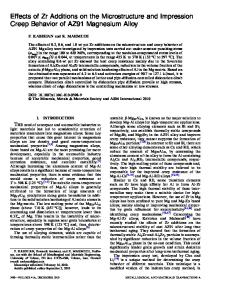Effects of heat treatment on the wear behavior of surfacing AZ91 magnesium alloy
- PDF / 744,197 Bytes
- 8 Pages / 584.957 x 782.986 pts Page_size
- 96 Downloads / 345 Views
Kai Tao and Qingfeng Zhu Key Laboratory of Electromagnetic Processing of Materials, Ministry of Education, Northeastern University, Shenyang 110819, China (Received 18 January 2017; accepted 24 April 2017)
The surfacing welding has been widely utilized in the industrial equipment manufacturing and repairs. The wear properties of surfacing alloys have an important effect on the whole performance of repaired components. The solution treatment (T4) and solution treatment followed by aging (T6) effects on the dry sliding wear behavior of surfacing AZ91 magnesium alloys with tungsten inert gas welding were investigated in this work. The results demonstrated that the surfacing alloy without treatment exhibited poor wear resistance, due to the massive intermetallic b-phases (Mg17Al12). These phases were believed to produce stress concentrations in the particleto-matrix interface and tended to generate cracks during friction. The T4 alloy had more improved wear resistance than the as-received alloy. The T6 treatment improved the wear resistance further, resulting from the high density dispersed fine b-phase precipitation in the a-Mg matrix, which enhanced the alloy strength and hardness and decreased the subsurface metal deformation degree caused by friction.
I. INTRODUCTION
Magnesium alloys have gradually been utilized for lightweight structural and functional parts in aircrafts, automotive applications, electronics, and other industry fields, due to the corresponding high specific strength, light specific weight, high damping capacity, recyclability, and electromagnetic shocks shielding ability.1 In contrast, local damage inevitably occurs at the magnesium equipment surfaces such as cracks, abrasion, and corrosion. These impairments seriously affect the service life and quality of these components. The overall replacement of damaged equipment caused a huge increase in costs. For this reason, it is proven necessary for the damaged parts to be repaired by utilization of suitable methods. The surfacing welding is the common repairing technology and has been widely utilized in the industrial equipment manufacturing, maintenance, and repairs.2,3 Generally, the properties of surfacing welding alloys, such as wear and corrosion resistance, have an important effect on the whole performance and life of the repaired magnesium components. The wear constitutes a serious problem in a high number of engineering applications such as bearings, moving parts, and engine parts. Although it is only a surface phenomenon, it might completely undermine Contributing Editor: Jürgen Eckert a) Address all correspondence to this author. e-mail: [email protected] DOI: 10.1557/jmr.2017.186
the mechanical function of engineering parts and cause a structural failure directly or as part of an effects combination.4 For the wear resistance improvement of the surfacing magnesium alloys, the heat treatment is one of the well-known methods for the expectations to be achieved. The heat treatment can affect wear through changes in the species and amounts of
Data Loading...











